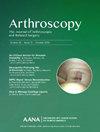Adhesive Capsulitis of the Shoulder
IF 4.4
1区 医学
Q1 ORTHOPEDICS
Arthroscopy-The Journal of Arthroscopic and Related Surgery
Pub Date : 2025-06-20
DOI:10.1016/j.arthro.2025.03.027
引用次数: 0
Abstract
Adhesive capsulitis is characterized by limited range of motion (ROM) due to adhesions within the glenohumeral joint capsule. The pathophysiology is suspected to involve an inflammatory reaction progressing to fibrotic contracture. Active fibroblastic proliferation can be found on histologic analysis, with some transformation to myofibroblasts, ultimately creating collagen in the form of a thick band. Clinically, adhesive capsulitis is classified into phases: freezing, frozen, and thawing. Risk factors include diabetes, hyperthyroidism, prior fractures, shoulder and cervical spine surgery, and radiation therapy. The condition affects 2% to 5% of individuals, with higher rates in women. While plain radiographs are often unremarkable, magnetic resonance imaging may reveal a thickened capsule, synovial hypertrophy, and joint capsule edema. Nonsurgical treatment focuses on pain relief and restoring ROM and includes physical therapy (PT), oral anti-inflammatory medications, corticosteroid injections, extracorporeal shock wave therapy, and ultrasonography-guided hydrodistention. Early corticosteroid injections are associated with shortened symptom duration and improved functional scores. Both a rotator interval approach, compared with a posterior approach, and lower dosages (10 mg vs 40 mg) of corticosteroid may lead to better pain relief and functional improvement. Ultrasound-guided hydrodilatation with hyaluronic acid combined with PT has also shown superior outcomes compared with PT alone. For patients with diabetes, extracorporeal shock wave therapy avoids potential metabolic complications from steroids. Adhesive capsulitis is self-limiting, with most patients achieving symptom resolution without surgery. Surgical intervention, typically considered after 9 to 12 months of failed nonsurgical management, includes arthroscopic capsular release, manipulation under anesthesia (MUA), or both. Both approaches are efficacious, with improved pain, ROM, and functional scores. Although MUA may be more cost-effective, arthroscopy allows direct visualization and treatment of pathology while reducing the risk of complications from MUA, such as fracture, dislocation, or nerve injury. Postoperative protocols emphasize early PT supplemented by multimodal pain management to maintain and improve ROM.
肩胶粘性囊炎
粘连性肩关节囊炎的特点是由于肩关节囊内的粘连导致活动范围受限。病理生理学怀疑与炎症反应进展为纤维化挛缩有关。在组织学分析中可以发现活跃的成纤维细胞增殖,并有一些转化为肌成纤维细胞,最终形成厚带形式的胶原蛋白。临床上,粘连性囊炎分为冻结期、冻结期和解冻期。危险因素包括糖尿病、甲状腺功能亢进、既往骨折、肩部和颈椎手术以及放射治疗。这种情况影响了2%到5%的人,女性的比例更高。虽然x线平片通常不明显,但磁共振成像可显示关节囊增厚、滑膜肥大和关节囊水肿。非手术治疗的重点是缓解疼痛和恢复ROM,包括物理治疗(PT),口服抗炎药物,皮质类固醇注射,体外冲击波治疗和超声引导下的水扩张。早期皮质类固醇注射与缩短症状持续时间和改善功能评分相关。与后路入路相比,旋转间隙入路和较低剂量(10mg vs 40mg)皮质类固醇均可更好地缓解疼痛和改善功能。超声引导透明质酸联合PT的水扩张也显示出比单独PT更好的结果。对于糖尿病患者,体外冲击波治疗可避免类固醇潜在的代谢并发症。粘连性囊炎是自限性的,大多数患者无需手术即可获得症状缓解。非手术治疗失败9至12个月后,通常考虑手术干预,包括关节镜下囊膜松解、麻醉下操作(MUA)或两者兼而有之。两种方法均有效,疼痛、ROM和功能评分均有改善。尽管MUA可能更具成本效益,但关节镜可以直接观察和治疗病理,同时降低MUA并发症的风险,如骨折、脱位或神经损伤。术后方案强调早期PT辅以多模式疼痛管理来维持和改善ROM。
本文章由计算机程序翻译,如有差异,请以英文原文为准。
求助全文
约1分钟内获得全文
求助全文
来源期刊
CiteScore
9.30
自引率
17.00%
发文量
555
审稿时长
58 days
期刊介绍:
Nowhere is minimally invasive surgery explained better than in Arthroscopy, the leading peer-reviewed journal in the field. Every issue enables you to put into perspective the usefulness of the various emerging arthroscopic techniques. The advantages and disadvantages of these methods -- along with their applications in various situations -- are discussed in relation to their efficiency, efficacy and cost benefit. As a special incentive, paid subscribers also receive access to the journal expanded website.

 求助内容:
求助内容: 应助结果提醒方式:
应助结果提醒方式:


